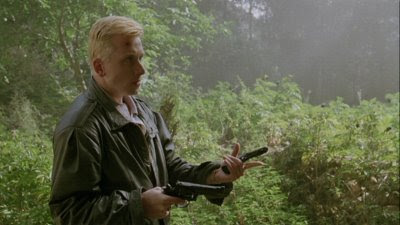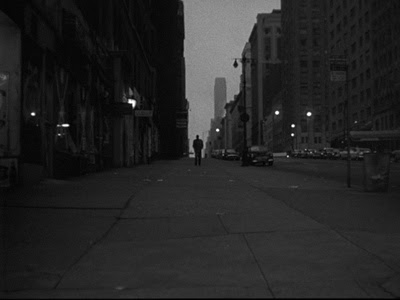 After the long (and ongoing!) discussion on Nobody's blog about No Country For Old Men, I couldn't stop comparing that movie to Stephen Frear's 1984 film The Hit. Both movies feature cold hit men and both use their characters to explore how people approach death.
After the long (and ongoing!) discussion on Nobody's blog about No Country For Old Men, I couldn't stop comparing that movie to Stephen Frear's 1984 film The Hit. Both movies feature cold hit men and both use their characters to explore how people approach death.The basic plot is that a "supergrass" (epic stool pigeon, played by Terence Stamp) who squealed on his former boss in exchange for immunity has been captured 10 years later in Spain. The two hit men, wonderfully played by Tim Roth and John Hurt, are taking him to Paris for execution. It's a bit of a road trip movie, and a lot happens along the way. The most important event is when they pick up a young woman named Maggie (Laura del Sol) as a bit of insurance against a colleague ratting them out.
Hurt's character (Braddock) is a seemingly emotionless professional hit man who is getting on in years. He wears dark sunglasses indoors and out, and despite his cool demeanor and professionalism, makes several mistakes. Roth (Myron) is a new kid, taken along on his first hit as Braddock's protege, eager to prove he has what it takes, yet obviously wet behind the ears and easily manipulated. Stamp (Willie) walks through the entire movie with a calm acceptance and a bit of playful maliciousness towards his fate and captors. His demeanor mystifies both Braddock and Myron. He cites his 10 years of book reading as the foundation for his new outlook on life and death.
**spoilers begin with the comparison of Braddock to Chigurh below**
Myron thinks he's ready to see death, to deal it, but each time he is given the opportunity he avoids it. By the end he's not so sure he wants to be a hit man at all. And, of course, he has no idea when it's coming for him, and his last words as Braddock's bullet goes through his eye are, "What's this?"
Willie has read books about life and death for 10 years, and seems very confident in his understanding of them. He goes along willingly (after his initial struggle when he is captured) for the entire ride, and even refuses to escape when given the opportunity. He seems to enjoy being "above" everyone else and mischievously causing trouble with Braddock and Myron. His mischief isn't innocent, either, as he gets a man killed by suggesting to Braddock that a particular man will squeal. He knew exactly what Braddock would do, and that it wouldn't affect his own fate at all, but he still does it. Yet, at the very end, when Braddock decides to execute everyone before they've crossed the border, Willie breaks down. He insists that he was supposed to die in Paris, according to the plan, and runs off, getting shot in the back. Braddock's response to Willie's change of heart is an incredulous, "You mouth!" Willie thought he had learned to accept death, but when he finally came face to face with it, it undid him. We'll never know how he would have responded had he actually met it in Paris as expected.
Braddock is the only figure of the group that actually deals death. I don't think he represents death as cleanly as Chigurh does, but he is clearly its agent. He knows he can't escape it forever, so he seems to have resigned himself to being its tool. He probably thinks that as its agent he has more control over his own time and place. His puzzlement at Willie's acceptance makes him question his own beliefs about death. He thought he understood it, but here is a man who doesn't seem to fear it at all. This causes him to question himself throughout the movie, and make "mistakes" that he normally wouldn't have, like sparing Maggie several times. Even after Willie shows his true colors and shatters the illusion that had been building, Braddock still ultimately spares Maggie, perhaps because she saw it coming and refused to accept it; she even physically fights Braddock on several occasions. Braddock is perhaps hopeful to retain the tiniest sliver of his humanity by sparing Maggie. Or, maybe he just respected her will to live. Minutes later, as he lay dying because of letting Maggie go, he winks at her, and has no choice but to accept his fate.
**end spoilers**
There's more to it than I've laid out here (I haven't mentioned the stylish production -- location, music, etc.), but that was the most interesting aspect to me, and I'd be curious to hear anyone else's opinion (especially you, Nobody).









